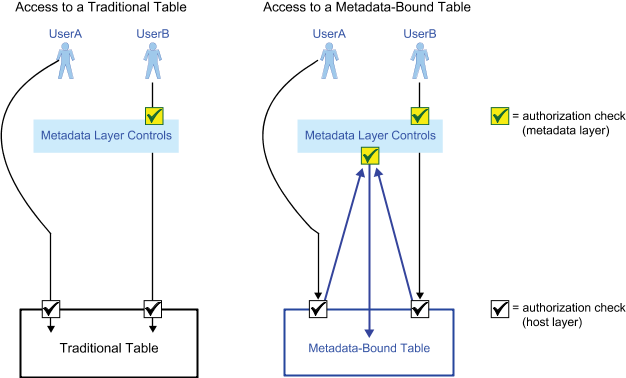Authorization Model for Metadata-Bound Tables
The following figure depicts the authorization model for a traditional table and a
metadata-bound table. In both cases, UserA references the target data directly (for example, through a
LIBNAME statement) and UserB requests the target data through a client that uses metadata to locate
data (for example, SAS Web Report Studio).
The preceding figure
depicts the following key difference:
-
When accessing a traditional table, a user can bypass metadata-layer controls by making a direct request.
-
When accessing a metadata-bound table, a user cannot completely bypass metadata-layer controls. Even on a direct request, UserA is always subject to a metadata-layer permissions check before accessing SAS data from SAS.
For the metadata-bound table, the upwards-facing arrows are caused by the physical
data’s security binding. For
each metadata-bound table, information within the table header identifies a corresponding
metadata object (a secured table object). Metadata-layer permissions on each secured table object affect access from SAS
to the corresponding physical table.
For the metadata-bound table, UserB is subject to two metadata-layer authorization
checks against two different
metadata objects.
-
The first check is against a traditional table object (for example, verifying that UserB has the ReadMetadata permission).
-
The second check is against a secured table object (for example, verifying that UserB has the Select permission).
Tip
In the SAS metadata, traditional
table objects and secured table objects are distinct and independent
types of objects. See Object Creation, Location, and Inheritance.Here are some additional
details about the preceding figure:
-
The requesting users do not supply library or table passwords.
-
The metadata-layer authorization checks are against the metadata identity of the requesting user. The host-layer authorization checks are against the identity of the SAS process that retrieves the data.
-
The figure addresses access to SAS data from SAS, not interaction through host commands.
-
The figure is conceptual, simplified, and abstracted. It is not intended as a detailed technical specification.
See Also
About Access to SAS Data in SAS Intelligence Platform: Security Administration Guide
Copyright © SAS Institute Inc. All rights reserved.
